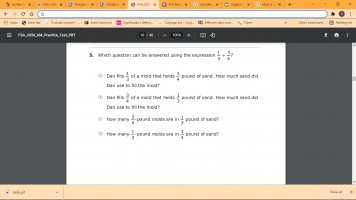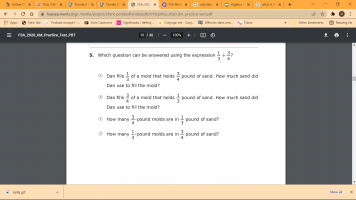You are using an out of date browser. It may not display this or other websites correctly.
You should upgrade or use an alternative browser.
You should upgrade or use an alternative browser.
Which question can be answered using the expression.......
- Thread starter eddy2017
- Start date
BeachBanana
Senior Member
- Joined
- Nov 19, 2021
- Messages
- 2,281
Go through each case, and answer the question. Which one requires you to compute [imath]\frac{1}{3}\div \frac{3}{4}?[/imath]Hi, I do not understand the phrasing of this question. what would be the first action to take to attack this?
thanks for any hint!
eddy
View attachment 31521
eddy2017
Elite Member
- Joined
- Oct 27, 2017
- Messages
- 2,525
BBB, I'll post my work tomorrow. Away from computer now.Go through each case, and answer the question. Which one requires you to compute [imath]\frac{1}{3}\div \frac{3}{4}?[/imath]
Morning, BBB, well t he answer to the operation is easy =4/9
Now the choices are giving me a hard time. you hinted at; which one requires me to compute the fractions?.
Uhhm...
I'd go for the last choice A
Dands fills 1/3 of a mold that holds 3/4 pound of sand
why, well 3/4 > than 1/3 .
BeachBanana
Senior Member
- Joined
- Nov 19, 2021
- Messages
- 2,281
Drawing a picture will help you grasp what the question is asking. In choice A, the sand mold can hold a total of 3/4 pounds of sand, but you only need to fill a third of the mold. Think about how much sand was put inside the mold.Morning, BBB, well t he answer to the operation is easy =4/9
Now the choices are giving me a hard time. you hinted at; which one requires me to compute the fractions?.
Uhhm...
I'd go for the last choice A
Dands fills 1/3 of a mold that holds 3/4 pound of sand
why, well 3/4 > than 1/3 .
eddy2017
Elite Member
- Joined
- Oct 27, 2017
- Messages
- 2,525
I put 1/3 = 0.333 of a poundDrawing a picture will help you grasp what the question is asking. In choice A, the sand mold can hold a total of 3/4 pounds of sand, but you only need to fill a third of the mold. Think about how much sand was put inside the mold.
in choice B mold I can only fit1/3 of a pound in and I put 3/4 (0.75) so it did not fit in.
in choice C..
I got it.
the answer is A
How many 1/3 OF A MOLD that holds 3/4 pouds of sand. (so it is a 3/4 pound of sand mould
I performed division to see how many time goes one into the other.
Last edited:
BeachBanana
Senior Member
- Joined
- Nov 19, 2021
- Messages
- 2,281
But you don't have 1-pound mold, you have a 3/4 pound mold!I put 1/3 = 0.333 of a pound
eddy2017
Elite Member
- Joined
- Oct 27, 2017
- Messages
- 2,525
we cross-posted. it is correct??But you don't have 1-pound mold, you have a 3/4 pound mold!
Rectified my post at # 5But you don't have 1-pound mold, you have a 3/4 pound mold!
Last edited:
BeachBanana
Senior Member
- Joined
- Nov 19, 2021
- Messages
- 2,281
It’s not correct. You are not understanding what the question is asking at all. Did you draw a picture like I asked? This question is testing your reading comprehension more than anything. Reread what I said in #4, let it sink in, draw a picture, try to understand the question.Rectified my post at # 5
D
Deleted member 4993
Guest
Is it the explanation or the numerical output (as suggested in #10) that is confounding you?Has to be C then
how many 3/4 pound mold are in 1/3 lb of sand?
but I am at a loss for an explanation.
I'll rephrase # 10 (in line with "phrases" in OP)
How many 2 lb mold can be filled with 16 lb sand?............... then ................
How many 3/4 lb mold can be filled with 1/3 lb sand?
eddy2017
Elite Member
- Joined
- Oct 27, 2017
- Messages
- 2,525
the phrasing of the choices. It makes it hard to understand where the thought should go.Is it the explanation or the numerical output (as suggested in #10) that is confounding you?
I'll rephrase # 10 (in line with "phrases" in OP)
How many 2 lb mold can be filled with 16 lb sand?............... then ................
How many 3/4 lb mold can be filled with 1/3 lb sand?
8You really should know this. If it was instead 16/2, the answer would be how many 2's are there in 16. The answer is the same with your unfriendly numbers.
4/9 lb mold can be filled with 1/3 lb sansIs it the explanation or the numerical output (as suggested in #10) that is confounding you?
I'll rephrase # 10 (in line with "phrases" in OP)
How many 2 lb mold can be filled with 16 lb sand?............... then ................
How many 3/4 lb mold can be filled with 1/3 lb sand?
1/3 would go into 3/4, as I see it, then
this is what I understand,
I still not get it. One question.
what does the result of the fraction operation has to do with all this?
what do I gain by performing the division of the two fractions that spits out 4/9 as a result?
what is that 4/9 useful in determining the choice?. Any hint there?
that is what is confusing. I performed the operation I got 4/9 so what?, does it make any difference? what about the result were 9/4?
Oh, okay, I thought it was still not right, then I started question why in the world I had to perform the operation given in the question if it doesn't mean help any to get me to the solution. Okay, all's well that ends well!.that is what is confusing. I performed the operation I got 4/9 so what?, does it make any difference? what about the result were 9/4?
thanks
ufff, it was a doozy!
The Highlander
Senior Member
- Joined
- Feb 18, 2022
- Messages
- 1,192
Hi eddy,I still not get it. One question.
what does the result of the fraction operation has to do with all this?
what do I gain by performing the division of the two fractions that spits out 4/9 as a result?
what is that 4/9 useful in determining the choice?. Any hint there?
that is what is confusing. I performed the operation I got 4/9 so what?, does it make any difference? what about the result were 9/4?
Oh, okay, I thought it was still not right, then I started question why in the world I had to perform the operation given in the question if it doesn't mean help any to get me to the solution. Okay, all's well that ends well!.
thanks
ufff, it was a doozy!
I saw you struggling with this problem the other day and even after you arrived at the correct answer you still seemed bewildered as to how that came about to be the right selection. Therefore, I thought I might chip in my tuppenceworth in an attempt to clear things up for you; apologies for having taken so long to do this but I've been busy elsewhere (with RLS
The first thing I think might help clarify matters is to convert the fractions involved so that they share a common denominator; this is often helpful in problems dealing with fractions. So, I have reworked the Problem replacing the fractions throughout with twelfths, however, in my comments, I still refer to thirds, quarters (and an occasional half) so you will need to bear in mind when reading the comments that:-
\(\displaystyle \frac{4}{12}\) = \(\displaystyle \frac{1}{3}\) and \(\displaystyle \frac{9}{12}\) = \(\displaystyle \frac{3}{4}\)
and be able to readily equate these fractions in your mind when going through the text!
The next thing to recognise is how the fractions are being used: in some cases they specify a proportion of some (measurable) quantity but in others they are being used more akin to labels, in a way, eg: when they talk about a \(\displaystyle \frac{3}{4}\)-lb mould it's just giving you a size (label?) for that vessel; you need to be absolutely clear in your mind what purpose each fraction serves.
The last thing I want to bring to your attention is the fact that, since this is all happening in one place & time, we can assume that the Density of the sand involved remains constant, therefore, its Weight (in lbs) is directly proportional to its Volume in, say, cubic inches (in³). And volume (rather then weight) is a much more useful parameter for us to work with when considering this problem. I am, therefore, asking you to believe that one pound of sand has a Volume of 12 in³ (it should eventually become clearer precisely why I've chosen the sand's Density to be \(\displaystyle \frac{1}{12}\) lbs/in³ when you read through my analysis).
I have re-arranged your original picture of the problem (below) and added my comments into it.
Please let me know if that aids your understanding of what's been going on here, huh?
PS: You may need to Save the attached picture to your own device and open it there in whatever picture viewing App you use in order to be able to read it "comfortably"; I found viewing it here in the forum was a bit fiddly!
Attachments
Last edited:



